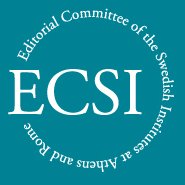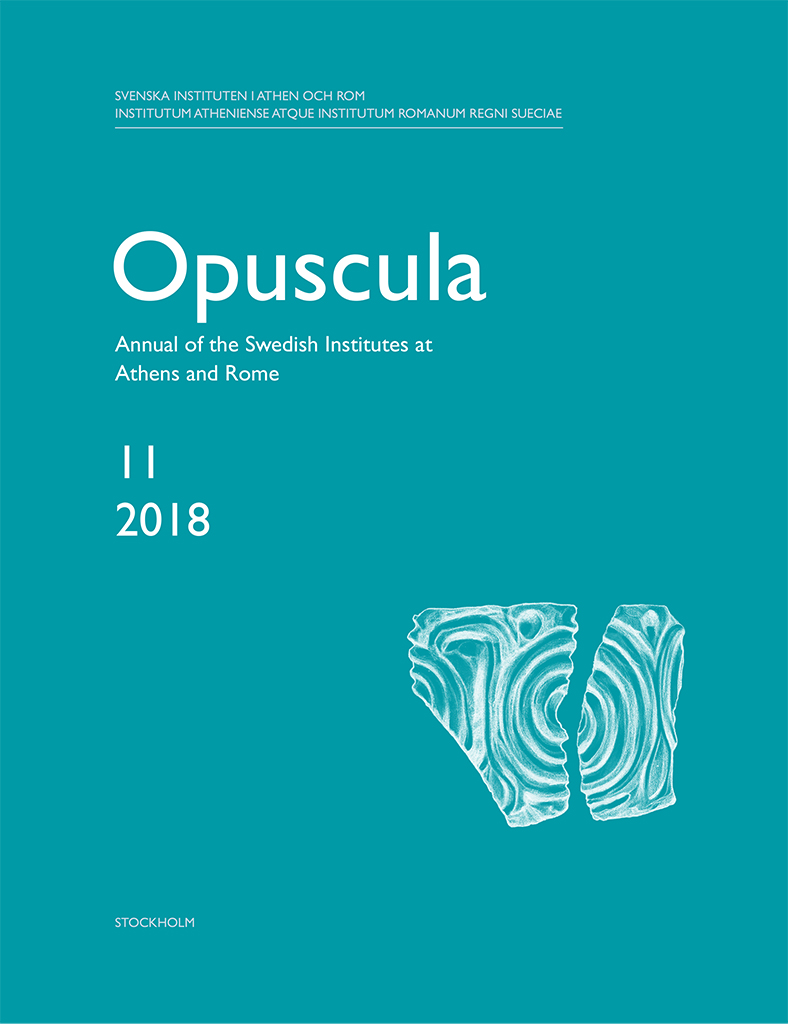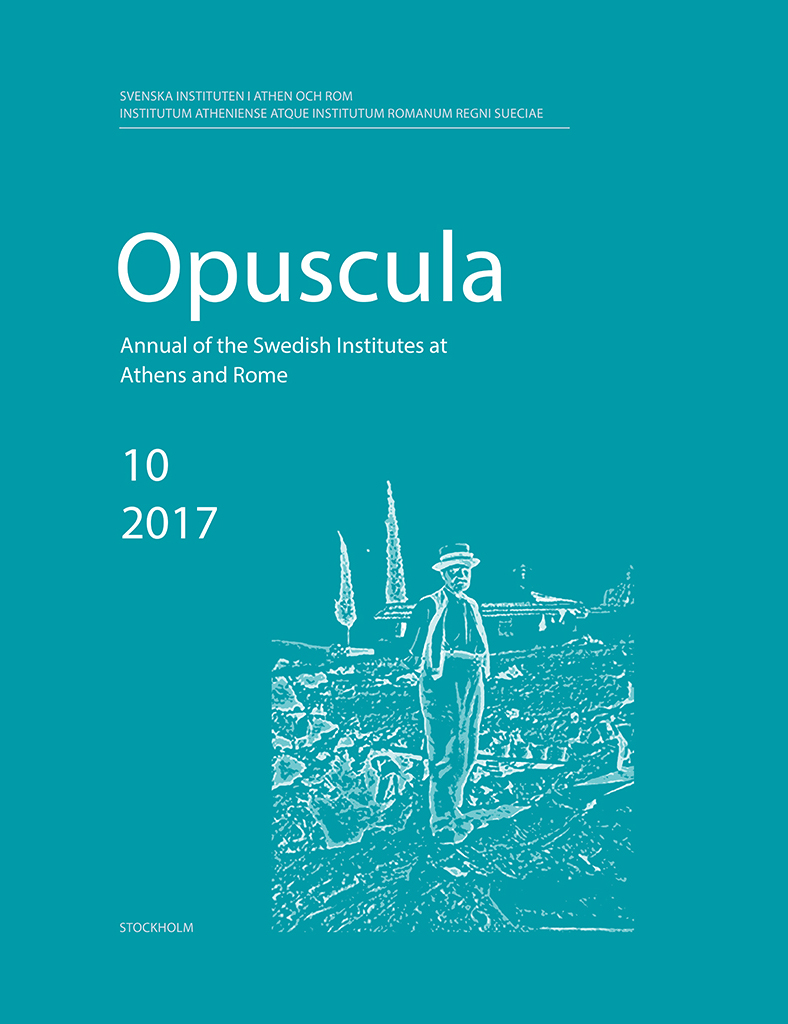Opuscula is published by the Swedish Institutes at Athens and Rome, with the aid of a grant from the Swedish Research Council. Distributed by Eddy.se AB. View journal at ERIH PLUS. All content available with open access. Painting early death. Deceased maidens on funerary vases in the National Archaeological Museum of Athens By Katia Margariti (Independent scholar, Greece). Abstract The present paper studies the iconography of dead maidens depicted on a red-figured funerary loutrophoros and six white-ground lekythoi in the National Archaeological Museum of Athens, all of them dating to the 5th century BC. The scenes painted on the vases under consideration are representative of the iconography employed by Classical Athenian vase-painters for the depiction of deceased maidens, parthenoi. Dead maidens are not frequently seen on funerary clay loutrophoroi, but mostly appear in psychopompoi, tomb visit, and prothesis scenes of white lekythoi, where their premature death before marriage is often emphasized by the fact that they are shown as brides through the use of wedding iconography elements. They are never portrayed being carried by Hypnos and Thanatos, but are only taken to Hades by Hermes and Charon. Even though the loutrophoros is generally considered to be the symbol par excellence…
Opuscula is published by the Swedish Institutes at Athens and Rome, with the aid of a grant from the Swedish Research Council. Distributed by Eddy.se AB. View journal at ERIH PLUS. All content available with open access. The use of miniature pottery in Archaic–Hellenistic Greek sanctuaries. Considerations on terminology and ritual practice By Signe Barfoed (Independent scholar, Norway). Abstract Miniature pottery is a widely encountered group of archaeological material that has been found in domestic, funerary, and predominantly in ritual contexts. Despite the ubiquitous presence of these small vessels, this group is generally understudied and interpretations of its meaning are lacking. Scholarship in the past perceived miniature pottery as cheap, non-functional and unimportant and therefore this pottery was often neglected or sometimes not even published. Interpretations have been sparse and by default it is believed that miniatures were the cheapest dedications the worshipper could buy. Within the last decade(s) the perceptions among scholars have changed somewhat and when miniature pottery and other votives appear together in an excavation it is often interpreted as a votive deposit stemming from a ritual context, such as a temple, shrine or sanctuary. Below a tentative terminology of miniature pottery will be presented and it…
Opuscula is published by the Swedish Institutes at Athens and Rome, with the aid of a grant from the Swedish Research Council. Distributed by Eddy.se AB. View journal at ERIH PLUS. All content available with open access. Tokens of piety. Inexpensive dedications as functional and symbolic objects By Gina Salapata (Massey University). Abstract This article engages with some methods and theories of disciplines outside the traditional sphere of Classics to open up new perspectives on the interrelationship between material culture, religion and society. It focuses on dedicatory practices and, in particular, on modest offerings and the multiple ways these were valued in Greek society. It concludes that, even though small inexpensive offerings were affordable by poorer people, their dedicators likely came from various socio-economic backgrounds. Dedications of low economic value and modest appearance may have had high symbolic value because they embodied social and religious ideas or the desires and identities of the dedicator; or they could derive their value from the function they performed in ritual. If the messages carried by such offerings were of primary concern and their value symbolic and emotional rather than material, the choice of a small or inexpensive offering would not necessarily reflect lower…
Opuscula is published by the Swedish Institutes at Athens and Rome, with the aid of a grant from the Swedish Research Council. Distributed by Eddy.se AB. View journal at ERIH PLUS. All content available with open access. Two Early Helladic II terracotta rollers from Asine and their glyptic context By Michael Lindblom (Uppsala University), Gullög Nordquist (Uppsala University) & Hans Mommsen (Universität Bonn). Abstract Two Early Helladic II terracotta rollers from the Third Terrace at Asine are presented. The objects, used to impress relief decoration on pithoi and hearths, are unique in that no other examples are known from the Early Bronze Age Aegean. Their origin is discussed based on chemical characterization and their depositional contexts are reviewed from an archaeological perspective. Although there are no known impressions from these rollers on pithoi and hearths at Asine, it is shown that their owners surrounded themselves with different objects featuring similar glyptic impressions. Two such impressions find identical parallels at Tiryns and the combined evidence strongly suggest that Asine was the home for one or several potters who produced Early Helladic impressed hearths and pithoi. Bibliographical information Michael Lindblom, Gullög Nordquist & Hans Mommsen, ’Two Early Helladic II terracotta rollers from…
Opuscula is published by the Swedish Institutes at Athens and Rome, with the aid of a grant from the Swedish Research Council. Distributed by Eddy.se AB. View journal at ERIH PLUS. All content available with open access. The New Swedish Cyprus Expedition 2017: Excavations at Hala Sultan Tekke (The Söderberg Expedition). Preliminary results By Peter M. Fischer (University of Gothenburg) & Teresa Bürge (Austrian Academy of Sciences). With contributions by Magda Ausiayevich, Bebelyn Placiente Robedizo, Victor Barrera Alarcón, Laerke Recht & Dominika Kofel. Abstract During the eighth field season at the Bronze Age city of Hala Sultan Tekke, excavations in City Quarter 1 (CQ1) exposed massive industrial and domestic structures belonging to three phases of occupation (Strata 3–1) dating to the 13th and 12th centuries BC (LC IIC–IIIA). Georadar survey, penetrating to a maximum depth of approximately 1 m, guided the excavation of walls of Strata 1–2, both of which were destroyed by conflagration. Excavations 1.5–2 m below the surface and also below the maximum penetration depth of the radar revealed a heretofore buried phase of occupation with substantial architectural units. For the first time, massive Stratum 3 structures with a markedly different building technique were exposed. Copper smelting installations,…
Opuscula is published by the Swedish Institutes at Athens and Rome, with the aid of a grant from the Swedish Research Council. Distributed by Eddy.se AB. View journal at ERIH PLUS. All content available with open access. Preliminary report of the Malthi Archaeological Project, 2015–2016 By Rebecca Worsham (Smith College), Michael Lindblom (Uppsala University) & Claire Zikidi (Independent scholar, Greece). Abstract This article offers preliminary results and tentative interpretations of new work at the previously excavated settlement of Malthi in Messenia, south-west Pelopponese. The work included an intensive survey of the site architecture, as well as test excavations of spaces within and outside of the fortification wall. We propose updated observations on the chronology and phasing of the site based on pottery dates from the new excavation and comment on the preserved architecture as it compares to other settlements of the period. The settlement appears to have been first inhabited in the second half of the Middle Helladic period. Little, if any, architecture from this phase can be securely identified today. At the beginning of the Late Helladic period a fortification was erected, and the entire layout of the site was transformed. The construction likely took place as a single…
Opuscula is published by the Swedish Institutes at Athens and Rome, with the aid of a grant from the Swedish Research Council. Distributed by Eddy.se AB. View journal at ERIH PLUS. All content available with open access. Opuscula. Annual of the Swedish Institutes at Athens and Rome 11, 2018 Contents Rebecca Worsham, Michael Lindblom & Claire Zikidi | Preliminary report of the Malthi Archaeological Project, 2015–2016 Peter M. Fischer & Teresa Bürge | The New Swedish Cyprus Expedition 2017: Excavations at Hala Sultan Tekke (The Söderberg Expedition). Preliminary results. With contributions by M. Ausiayevich, B. Placiente Robedizo, V. Barrera Alarcón, L. Recht & D. Kofel Michael Lindblom, Gullög Nordquist & Hans Mommsen | Two Early Helladic II terracotta rollers from Asine and their glyptic context Gina Salapata | Tokens of piety. Inexpensive dedications as functional and symbolic objects Signe Barfoed | The use of miniature pottery in Archaic–Hellenistic Greek sanctuaries. Considerations on terminology and ritual practice Katia Margariti | Painting early death. Deceased maidens on funerary vases in the National Archaeological Museum of Athens Susanne Berndt | The hand gesture and symbols of Sabazios Chrysanthos Kanellopoulos & Manolis Petrakis | Cella alignment and 4th century BC Doric peripteral temple architecture…
Opuscula is published by the Swedish Institutes at Athens and Rome, with the aid of a grant from the Swedish Research Council. Distributed by Eddy.se AB. View journal at ERIH PLUS. All content available with open access. Dissertation abstracts 2016–2017 Martina Björk | Ovid’s Heroides and the ethopoeia, PhD thesis, Centre for Language and Literature, Lund University 2016. http://lup.lub.lu.se/record/53979082-4854-4225-aa86-8f4235c1f48c Patrik Klingborg | Water and risk in ancient Greece, 600–50 BC, PhD thesis, Department of Archaeology and Ancient History, Uppsala University 2017. http://urn.kb.se/resolve?urn=urn:nbn:se:uu:diva-316811 Paulina Partanen | Navigating female power: (De-)constructing the space of the immortal threat in Homer’s Odyssey, Department of Theology: History of Religions, Uppsala University 2016. http://urn.kb.se/resolve?urn=urn:nbn:se:uu:diva-286865 Bibliographical information ‘Dissertations 2016–2017′, Opuscula. Annual of the Swedish Institutes at Athens and Rome (OpAthRom) 10, Stockholm 2017, 196–197. ISSN: 2000-0898. ISBN: 978-91-977798-9-0. https://doi.org/10.30549/opathrom-10-12
Opuscula is published by the Swedish Institutes at Athens and Rome, with the aid of a grant from the Swedish Research Council. Distributed by Eddy.se AB. View journal at ERIH PLUS. All content available with open access. Book reviews Fredrik Tobin | S. Bell & A. A. Carpino (eds.), A companion to the Etruscans, Chichester: Wiley-Blackwell 2016. xxviii + 493 pp. ISBN 978-1-118-35274-8. https://doi.org/10.30549/opathrom-10-09 Pedro Bentancour Garin | I. McPhee, Myth, Drama and Style in South Italian Vase-Painting: Selected Papers by A.D. Trendall (Studies in Mediterranean Archaeology and Literature PB 182), Uppsala: Åströms Förlag 2016. xxxix + 299 pp. ISBN 978-91-7081-205-7. https://doi.org/10.30549/opathrom-10-10 Hedvig von Ehrenheim | G. Renberg, Where dreams may come. Incubation sanctuaries in the Greco-Roman world, vols. 1–2 (Religions in the Greco-Roman world 184), Leiden & Boston: Brill 2016. 1046 pp. ISBN 978-90-04-29976-4 (hardback set) ISBN 978-90-04-34621-5 (hardback, vol. 1) ISBN 978-90-04-34622-2 (hardback, vol. 2) ISBN 978-90-04-33023-8 (e-book). https://doi.org/10.30549/opathrom-10-11 Bibliographical information ‘Book reviews’, Opuscula. Annual of the Swedish Institutes at Athens and Rome (OpAthRom) 10, Stockholm 2017, 190–195. ISSN: 2000-0898. ISBN: 978-91-977798-9-0.
Opuscula is published by the Swedish Institutes at Athens and Rome, with the aid of a grant from the Swedish Research Council. Distributed by Eddy.se AB. View journal at ERIH PLUS. All content available with open access. The last occupation of Asine in Argolis By Nektarios-Peter Yioutsos Abstract Kastraki Hill on the eastern Argolic Gulf, with visible remains of impressive fortifications, has been identified since the mid-19th century as the position occupied by the acropolis of ancient Asine. The first systematic excavations were carried out by the Swedish Institute in the 1920s and revealed the continuous habitation of the site from the Early Helladic period (3rd millennium BC) up to the late 4th-early 5th century AD. Many additions and repairs on the acropolis were made during the Byzantine period and the 2nd Venetian Occupation of the Peloponnese (1686–1715). However, the most destructive interventions in the area are the works carried out by the Italians during World War II. Fearing an invasion of the Allies on this side of the Peloponnese, the Italians fortified the acropolis by making additions to the ancient walls and constructing auxiliary buildings, pillboxes, observation posts and trenches around the rocky outcrop using materials from buildings of…



